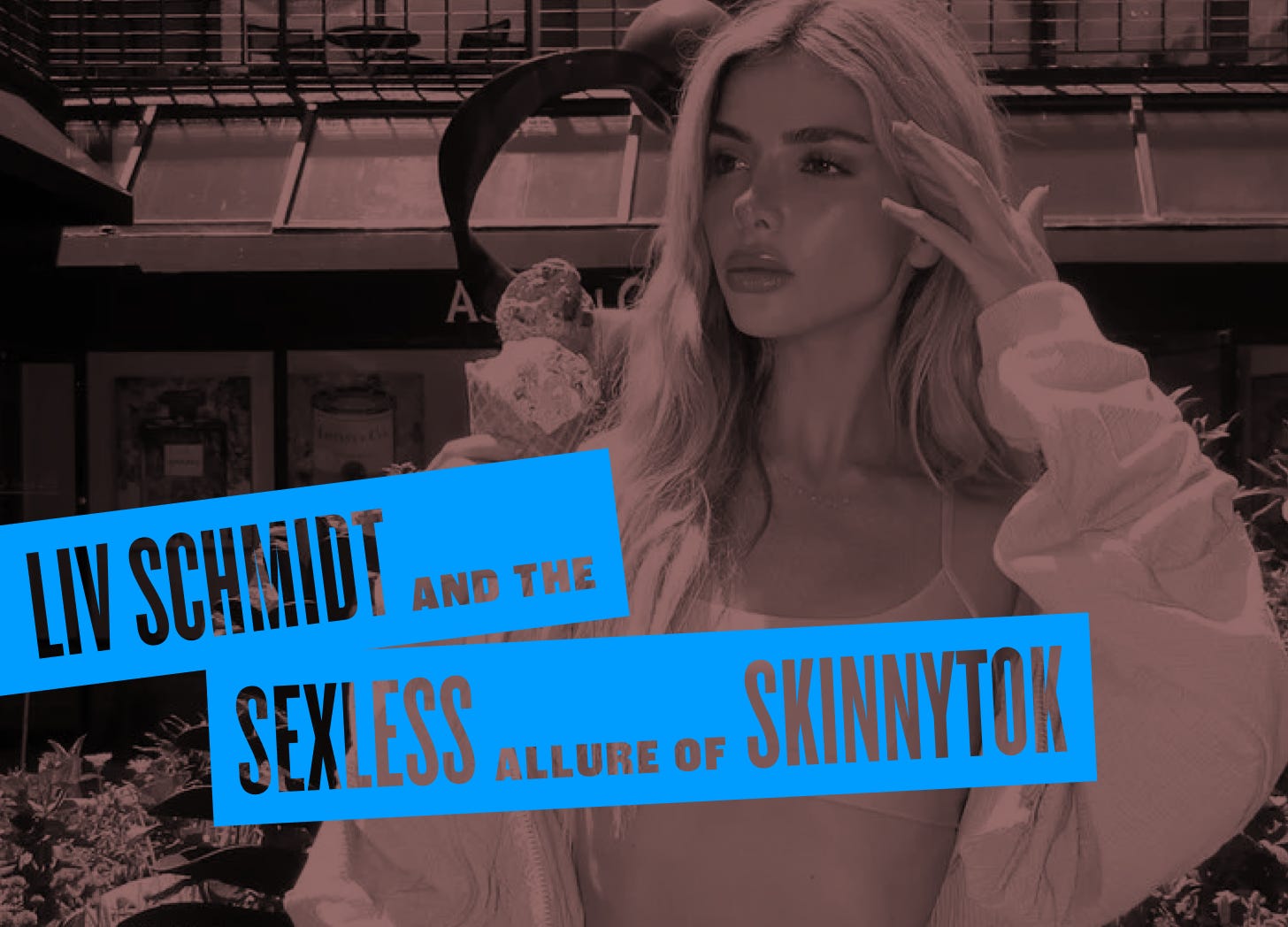SkinnyTok is full of contradictions: You’ll hear you need to work hard to lose weight so you can be effortlessly chic; you’ll discover a world of corporeal obsession in which possessing a “hot body” is the ultimate form of pleasure. So why does it all feel so sterile?
A brief content warning: In order to dissect the rhetoric that drives eating disorders, we’re sharing examples in this episode. If you aren’t interested in being exposed to the toxic dumpsite that is anti-fatness, feel free to skip this one—though we think you’ll like where it lands.
Liv Schmidt first entered public consciousness outside the niche subculture of “SkinnyTok” in September 2024 in The Wall Street Journal, in which she explained that she’s simply honest about what it takes to be rail-thin, which is ‘what the viewers want.’
Four days later, an incredibly similar piece ran in The New York Times—but with a twist. After the Journal had reached out to TikTok for comment, Liv’s account was banned. A woke-mob-cancel-culture-free-speech story was brewing, which meant it wasn’t long before…
Evie Magazine’s team of crack reporters1 were on the scene, bitch!2 On the surface, Liv’s ideas could be borrowed straight from the women’s magazines of the early 2000s—much of it (portion control; moderation) feels relatively uncontroversial.

But something you’ll notice after spending a lot of time in this space is the level of semantic footwork required to keep the wheels turning—and this is rendered in sharper focus in EJ Dickson’s recent explosive piece for The Cut in which we’re taken behind the paywall to learn that where the public message is, “Don’t count calories,” the private message is, “…but write down every single thing you eat.”
Liv’s private Instagram group was a breeding ground for eating disorder self-selection, a dangerous spin on “the power of community” when one considers that anorexia has the highest mortality rate of any mental illness.
Of course, these revelations led to a flurry of institutional distancing—her page on the Elite Models website 404’d; she was demonetized on Meta. But these very same power centers benefit3 from the ideas she propagates—and she might just be too forthcoming about what those ideals require.
Liv isn’t alone on SkinnyTok—there’s also a fat loss coach named Amanda Dobson, whose rhetoric makes some of SkinnyTok’s subtler contradictions plainer.

Much of what’s been interesting about watching the response to Liv and SkinnyTok more broadly has been the narrative framing around a key phrase: “Nothing tastes as good as skinny feels,” an idea that—supposedly—used to be popular, fell out of fashion, and has now come back in vogue, a proxy for the lifecycle of the broader attitude it captures. But have we ever overtly acknowledged this ideal?
Or maybe—just maybe—has the penalty for living in a fat body actually just been getting worse the whole time? Between 2000 and 2018, eating disorder incidence doubled from 3.4% to 7.8% of the population.
And by “getting worse,” of course I mean only for women, as there’s “very little association between economic standing and body fat” for men. In that sense, as The Economist pointed out, it’s always been “economically rational” for women to try to be as thin as possible.
…why is why creators like Liv found such a ready-made audience of (mostly) women who were relieved to abandon the dual labor of (a) trying to meet a beauty standard while (b) pretending it didn’t exist and denying its power.
It’s also interesting when you consider this is playing out against a backdrop of economic precarity, in which the middle class is clinging more desperately to stability, a socioeconomic class characterized by a reverence for self-discipline and work ethic—two ideas exonerated in Skinny rhetoric.
Now take this centuries-old cultural conversation (c/o Sabrina Strings and Fearing the Black Body)…and medicalize it. Enter: the 1998 BMI measure shift from the upper limit of “normal” weight for women from 27 to 25, the resultant “obesity epidemic,” and weight loss drugs.
As you engage in the moral panic about fatness, please disregard the fact that research which reviewed 82 studies comprising 2.7 million patients finds those with a BMI between 25-30 (technically “pre-obese” in the post-1998 parlance and scoring) had the lowest mortality rate. It’d also be great if you could disregard the fact that not only have humans gotten heavier over time, they’ve also gotten taller.
It almost seems like if we wanted to have an intellectually honest moral panic about something shaving years off the lives of millions of Amerians, we’d stop talking about people’s bodies and start talking about their income: “The gap in life expectancy between the richest 1 percent and the poorest 1 percent was 10 years for women and nearly 15 years for men,” a staggering gap compared to the more modest estimate of 3–7 years of lifespan estimated to be lost for those with a BMI greater than 35.
And lest we think that women are the only people affected by these accelerating body norms, I hereby enter into evidence:
That’s right. The flip side of SkinnyTok is SteroidTok. So honestly, where do we draw the line? While neurotic counting, tracking, and obsessing is considered maladaptive and dangerous in the context of weight loss, we’re strangely comfortable with externalizing our health markers to wearable health trackers—like the Oura Ring, which we both wore during this recording4, which was the center of some reporting earlier this year about how it’s creating “health paranoia” in users.
So not to be all, “Does Hannah Neeleman have free will?”5 again, but … what even is health, actually? Put another way: to what end?
Really, the most interesting thing about the resurgence of thinness is the fact that the rewards for achieving it have been there all along—and now that our bodies are becoming AI-ified (cc: Hugh Jacked, Man), the result is blindingly sterile and sexless: As RS Benedict put it, “Everyone is beautiful and no one is horny.”
A body is no longer a holistic system. It is not the vehicle through which we experience joy and pleasure during our brief time in the land of the living. It is not a home to live in and be happy. It, too, is a collection of features: six pack, thigh gap, cum gutters. And these features exist not to make our lives more comfortable, but to increase the value of our assets. Our bodies are investments, which must always be optimized to bring us… what, exactly?
In conclusion: embodiment > empowerment6
brittany hugoboom for the love of god please take this footnote as our official offer for an editor, we’ll pay for it
paging bari weiss, your beat is calling
like the dystopian revelation that Sarah Wynn-Williams alleged in Careless People, that Meta developed technology to target 13-to-17-year-old girls with beauty product ads after it sensed a selfie had been deleted
according to Oura my heart rate spiked most when we encountered the third example of Evie repeating itself
#tbt to AgriCulture Wars, our very first episode
that’s trademarked patented copyrighted diabolical lies fyi merch forthcoming



















